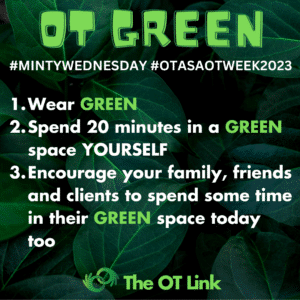 Why Green?
Why Green?
Spring is indeed a special time of the year, with the delightful sight of light green leaves adorning the once-bare winter tree branches and plants awakening with buds and vibrant blooms. It’s a season teeming with evidence of growth and life. Interestingly, OT week coincides with the rejuvenation of Spring, and it’s fitting that occupational therapy interventions should parallel this theme by nurturing growth in the lives of the individuals we serve.
The concept of “green time” refers to the time we spend immersed in nature. Instinctively, we recognize that when life gets overwhelming or our moods dip, escaping outdoors has a remarkable ability to clear our minds. This is substantiated by evidence. In fact, spending time in nature has consistently been linked to improved mental well-being.
Research has revealed that a stronger connection to nature is correlated with lower levels of depression and stress, along with an overall enhanced sense of well-being [1]. Nature-based interventions (NBIs), such as participating in nature walking groups, have garnered favorable reviews from mental health professionals and offer substantial benefits to mental health consumers. These benefits encompass improved mood, a heightened sense of calmness, relaxation, empowerment, and strengthened social connections [2]. Even among college students, venturing outdoors during “green time” has been associated with reduced stress and depression [3]. The therapeutic potential of nature extends to an extensive range of mental health outcomes, from alleviating symptoms of psychiatric disorders to boosting cognitive abilities [4]. Simply put, interacting with nature, especially through outdoor activities, has the capacity to alleviate stress, anxiety, and depression, thereby mitigating the severity of mental health challenges [5].
The positive influence of green spaces isn’t limited to specific populations; it extends to the broader public as well. Studies have consistently shown that exposure to green spaces has stress-reducing and mood-enhancing effects on the general population [6]. Engagement with natural environments, such as forests, has consistently yielded reports of significantly elevated positive emotions among participants [7]. Moreover, the happiness quotient of individuals tends to rise in the presence of nature, offering a potential avenue to reduce disparities in mental health [8]. Living in areas with ample greenery has been associated with better overall mental health, although few studies have delved specifically into its impact on depression [9]. Given the ongoing urbanization trends, there’s a pressing need for collaboration between mental health professionals and urban planners to integrate high-quality green spaces into urban design [10].
Let us embrace our OT green and the benefits of green space and green time. Let us harness the healing power of nature for our own well-being and for the benefit of those we serve.
#mintywednesday #day3OTASAOTweek2023 #OTASAOTWeek2023 #occupationaltherapy #occupationaltherapist #OTgreen #green #facilitatinggrowth
References:
1 Claire, L, Wicks., Jo, Barton., Leanne, Andrews., Sheina, Orbell., Gavin, Sandercock., Carly, Wood. The Impact of the Coronavirus Pandemic on the Contribution of Local Green Space and Nature Connection to Mental Health. International Journal of Environmental Research and Public Health, (2023).;20(6):5083-5083. doi: 10.3390/ijerph20065083
2 Rachel, Tambyah., Katarzyna, J, Olcon., Julaine, Allan., Pete, Destry., Thomas, Astell-Burt. Mental health clinicians’ perceptions of nature-based interventions within community mental health services: evidence from Australia. BMC Health Services Research, (2022).;22(1) doi: 10.1186/s12913-022-08223-8
3 Alexa, Deyo., Joshua, Wallace., Katherine, M., Kidwell. Screen time and mental health in college students: Time in nature as a protective factor.. Journal of American College Health, (2023).1-8. doi: 10.1080/07448481.2022.2151843
4 Marilisa, Herchet., Suchithra, Varadarajan., Iris-Tatjana, Kolassa., Mathias, Hofmann. How Nature Benefits Mental Health. Zeitschrift Fur Klinische Psychologie Und Psychotherapie, (2022).;51(3-4):223-233. doi: 10.1026/1616-3443/a000674
5 Jonah, E., Trevino., Muntazar, Monsur., Carol, Shepherd, Lindquist., Catherine, R., Simpson. Student and Nature Interactions and Their Impact on Mental Health during the COVID-19 Pandemic. International Journal of Environmental Research and Public Health, (2022).;19(9):5030-5030. doi: 10.3390/ijerph19095030
6 Emily, J., Rugel. Green Space and Mental Health: Pathways, Impacts, and Gaps. (2015).
7 Chiew-Jiat, Siah., Ee, Heok, Kua., Yong-Shian, Goh. The impact of restorative green environment on mental health of big cities and the role of mental health professionals. Current Opinion in Psychiatry, (2022). doi: 10.1097/YCO.0000000000000778
8 Natasha, Gilbert. Green space: A natural high. Nature, (2016). doi: 10.1038/531S56A
9 A, Callaghan., Geoff, McCombe., Aine, Harrold., C, McMeel., Gerald, Mills., Niamh, Moore-Cherry., Walter, Cullen. The impact of green spaces on mental health in urban settings: a scoping review. Journal of Mental Health, (2021). doi: 10.1080/09638237.2020.1755027
10 Rachel, F., Banay., Peter, James., Jaime, E., Hart., Jaime, E., Hart., Laura, D., Kubzansky., Donna, Spiegelman., Olivia, I., Okereke., Olivia, I., Okereke., John, D., Spengler., Francine, Laden., Francine, Laden. Greenness and Depression Incidence among Older Women.. Environmental Health Perspectives, (2019). doi: 10.1289/EHP1229
By Lauren Michell MSc (OT)
Partner at The OT Link

 Why Green?
Why Green?